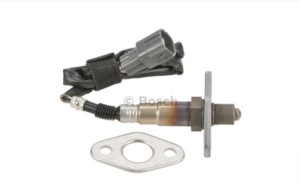Oxygen sensors are critical components in your vehicle’s emission control system. They monitor the amount of oxygen in the exhaust and relay this information to the engine control unit (ECU), which adjusts the air-fuel mixture for optimal combustion. A faulty O2 sensor can lead to reduced fuel efficiency, increased emissions, and potential damage to other engine parts. So, How Much Does It Cost To Replace An O2 Sensor? Let’s break down the factors involved.
What Is an Oxygen Sensor and Why Is It Important?
Depending on the vehicle’s design, a car can have one to four oxygen sensors. Typically, you’ll find one after the catalytic converter (downstream O2 sensor) and often one before it (upstream O2 sensor). Vehicles with two engine banks may have an upstream sensor for each bank, a downstream sensor, and sometimes a rear sensor.
 Bosch Exact Fit Oxygen Sensor
Bosch Exact Fit Oxygen Sensor
Properly functioning oxygen sensors are essential for:
- Fuel Efficiency: Ensuring the car burns fuel efficiently by maintaining the correct air-fuel mixture.
- Emission Control: Reducing harmful emissions to meet environmental standards.
- Preventing Damage: Protecting components like the catalytic converter from damage due to improper combustion.
Signs Your Oxygen Sensor Needs Replacement
Recognizing the symptoms of a failing oxygen sensor early can save you money and prevent further damage. Here are some common indicators:
- Check Engine Light: The most common sign is the illumination of the Check Engine light on your dashboard. A diagnostic scan will likely reveal an O2 sensor-related error code.
- Poor Fuel Economy: A malfunctioning sensor can cause your engine to run too rich (too much fuel) or too lean (not enough fuel), leading to decreased fuel efficiency. You might notice more frequent trips to the gas station.
- Rough Idle or Misfires: An incorrect air-fuel mixture can cause the engine to idle roughly or misfire, especially at low speeds or when the car is stationary.
- Increased Emissions: If your vehicle fails an emissions test, a faulty oxygen sensor could be the culprit. These sensors are vital for controlling emissions levels.
- Engine Hesitation: You may experience delays in acceleration or a noticeable lack of power when trying to speed up.
If you notice any of these signs, it’s time to consider the cost of O2 sensor replacement.
Average Oxygen Sensor Replacement Costs
The total cost to replace an oxygen sensor can vary widely, depending on whether you opt for a DIY approach or hire a professional mechanic.
DIY Oxygen Sensor Replacement
Replacing an oxygen sensor yourself can cost between $20 and $300 per sensor. The price depends on your vehicle’s make and model and the brand of the sensor. While this is a more budget-friendly option, it requires mechanical knowledge, basic tools (like wrenches and sockets), and a scan tool to clear any error codes after the replacement.
Professional Oxygen Sensor Replacement
Hiring a mechanic typically ranges from $150 to $600, including both parts and labor. Labor rates can significantly impact the overall cost, varying by location and the complexity of the job. Dealerships often charge higher labor rates compared to independent shops.
Factors Affecting Replacement Costs
Several factors influence the cost of replacing an oxygen sensor:
- Vehicle Make and Model: The make, model, and age of your vehicle significantly impact the cost of parts and labor. Luxury or high-performance vehicles often require more expensive sensors and specialized labor.
- Sensor Location: Some sensors are easier to access than others. If a sensor is difficult to reach, the mechanic will need more time for the replacement, increasing labor costs.
- Labor Rates: Labor rates vary widely by location. Urban areas with higher costs of living generally have higher labor rates. Dealerships tend to charge more than independent shops.
- Sensor Type: There are different types of oxygen sensors, including heated and unheated sensors, as well as wideband sensors used in some modern vehicles. The type of sensor your car requires will affect the part cost.
Tips to Extend the Lifespan of Your Oxygen Sensor
While replacing an oxygen sensor is often inevitable, proper maintenance can extend its lifespan. Here are some tips:
- Use High-Quality Fuel: Premium fuels often contain fewer impurities, reducing buildup on the sensors.
- Regular Maintenance: Schedule regular engine tune-ups and ensure your fuel and exhaust systems are clean.
- Address Leaks Promptly: Fix oil or coolant leaks quickly to prevent contamination of the sensors, which can cause premature failure.
- Avoid Frequent Short Trips: Short trips prevent the engine from reaching optimal operating temperature, leading to incomplete combustion and buildup on sensors. Opt for longer drives when possible.
By following these tips, you can potentially delay the need for O2 sensor replacement and ensure your vehicle operates efficiently for longer.
FAQ About Oxygen Sensor Replacement
- What are the symptoms of a bad oxygen sensor? Common symptoms include a Check Engine light, poor fuel economy, rough idling, increased emissions, and engine hesitation.
- Can I drive with a faulty oxygen sensor? While possible, driving with a faulty oxygen sensor for an extended period can lead to engine damage and increased emissions. It’s best to address the issue as soon as possible.
- Is replacing an oxygen sensor a DIY-friendly job? Yes, if you have the necessary tools and some mechanical experience. However, if you’re not comfortable working on cars, it’s best to seek professional help.
- What happens if you don’t replace a bad oxygen sensor? Failing to replace a bad oxygen sensor can result in poor engine performance, reduced fuel efficiency, potential damage to the catalytic converter, and a failed emissions test.
In conclusion, the cost to replace an O2 sensor varies depending on several factors, including your vehicle’s make and model, the location of the sensor, labor rates, and whether you choose to DIY or hire a professional. By understanding these factors and maintaining your vehicle properly, you can make an informed decision and potentially extend the life of your oxygen sensors.